A Look At Triple-GPU Performance And Multi-GPU Scaling, Part 1
by Ryan Smith on April 3, 2011 7:00 AM ESTCiv V, Battlefield, STALKER, and DIRT 2
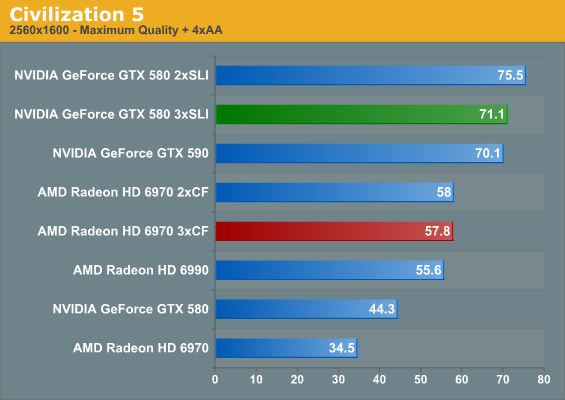
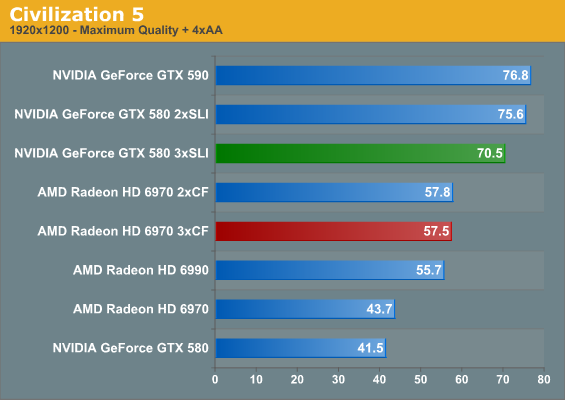
Civilization V continues to be the oddball among our benchmarks. Having started out as a title with low framerates and poor multi-GPU scaling, in recent months AMD and NVIDIA have rectified this some. As a result it’s now possible to crack 60fps at 2560 with a pair of high-end GPUs, albeit with some difficulty. In our experience Civ V is a hybrid bottlenecked game – we have every reason to believe it’s bottlenecked by the CPU at certain points, but the disparity between NVIDIA and AMD’s performance indicates there’s a big difference in how the two are settings things up under the hood.
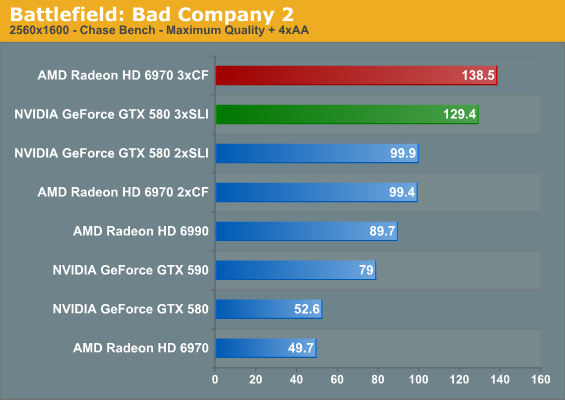
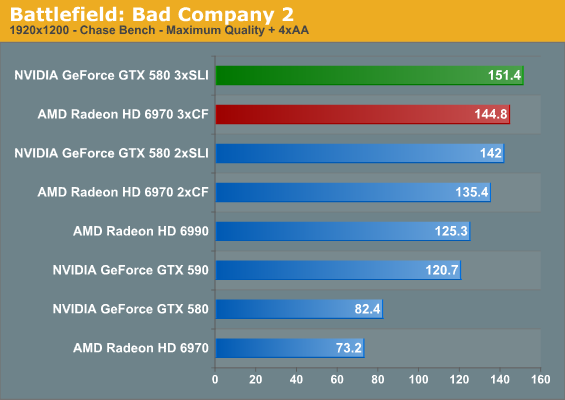
When we started using Bad Company 2 a year ago, it was actually a rather demanding benchmark; anything above 60fps at 2560 required SLI/CF. Today that’s still true, but at 52fps the GTX 580 comes close to closing that gap. On the flip side two GPUs can send scores quite a distance up, and three GPUs will push that over 120fps. Now if we could just get a 120Hz 2560 monitor…
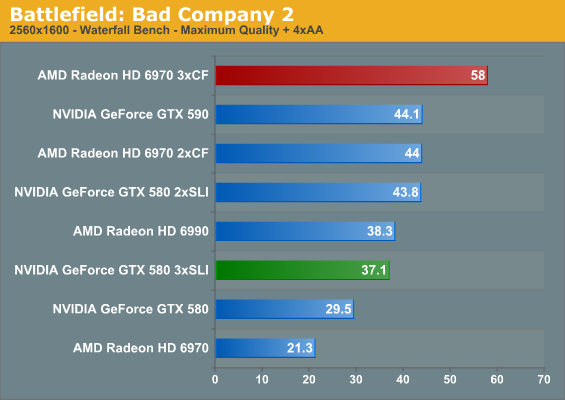
The Bad Company 2 Waterfall benchmark is our other minimum framerate benchmark, as it provides very consistent results. NVIDIA normally does well here with one GPU, but with two GPUs the gap closes to the point where NVIDIA may be CPU limited as indicated by our 580SLI/590 scores. At three GPUs AMD falls just short of a 60fps minimum, while the triple GTX 580 setup drops in performance. This would indicate uneven performance scaling for NVIDIA with three GPUs.
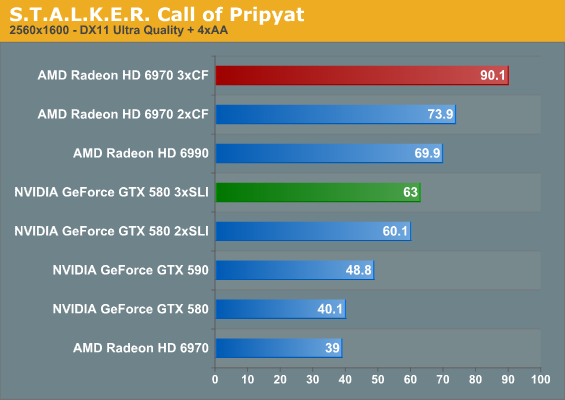
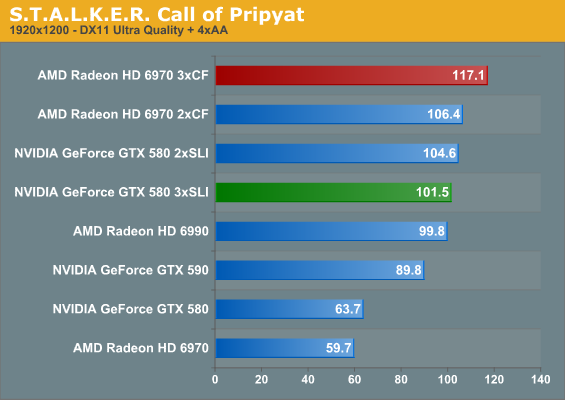
STALKER is another title that is both shader heavy and potentially VRAM-intensive. When moving from 1GB cards to 2GB cards we’ve seen the average framerate climb a respectable amount, which may be why AMD does so well here with multiple GPUs given the 512MB advantage in VRAM. With three GPUs the GTX 580 can crack 60fps, but the 6970 can clear 90fps.
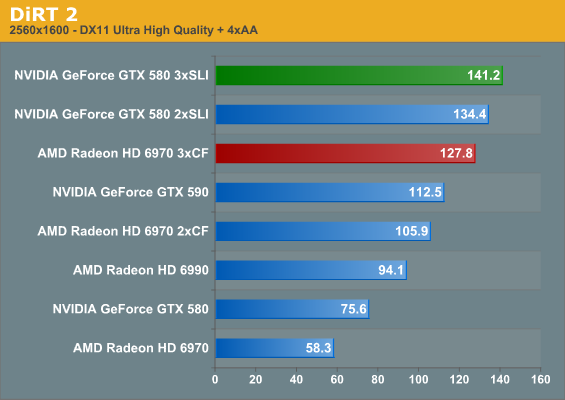
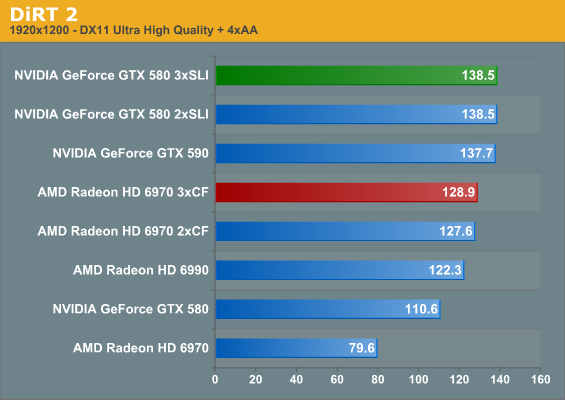
We’ve seen DiRT 2 become CPU limited with two GPUs at 1920, so it shouldn’t come as a surprise that with three GPUs a similar thing happens at 2560. Although we can never be 100% sure that we’re CPU limited versus just seeing poor scaling, the fact that our framerates top out at only a few FPS above our top 1920 scores is a solid sign of this.
| Radeon HD 6970 | GeForce GTX 580 | |||||
| GPUs | 1->2 | 2->3 | 1->3 | 1->2 | 2->3 | 1->3 |
| Civilization V | 168% | 99% | 167% | 170% | 95% | 160% |
| Battlefield: BC2 Chase | 200% | 139% | 278% | 189% | 129% | 246% |
| Battlefield: BC2 Water | 206% | 131% | 272% | 148% | 85% | 125% |
| STALKER: CoP | 189% | 121% | 231% | 149% | 104% | 157% |
| DiRT 2 | 181% | 120% | 219% | 177% | 105% | 186% |
So what does multi-GPU scaling look like in this batch of games? The numbers favor AMD at this point, particularly thanks to STALKER. Throwing out a CPU limited DIRT 2, and the average FPS for an AMD card moving from one GPU to two GPUs is 185%; NVIDIA’s gains under the same circumstances are only 169%.
For the case of two GPUs, AMD’s worst showing is Civilization V at 168%, while for NVIDIA it’s STALKER at %149. In the case of Civilization V the close gains to NVIDIA (168% vs. 170%) hides the fact that the GTX 580 already starts out at a much better framerate, so while the gains are similar the final performance is not. STALKER meanwhile presents us with an interesting case where the GTX 580 and Radeon HD 6970 start out close and end up far apart; AMD has the scaling and performance advantage thanks to NVIDIA’s limited performance gains here.
As for scaling with three GPUs, as was the case with two GPUs the results are in AMD’s favor. We still see some weak scaling at times – or none as in the case of Civilization V – but AMD’s average gain of 120% over a dual-GPU configuration isn’t too bad. NVIDIA’s average gains are basically only half AMD’s though at 110%, owing to an even larger performance loss in Civilization V, and almost no gain in STALKER. Battlefield: Bad Company 2 is the only title that NVIDIA sees significant gains in, and while the specter of CPU limits always looms overhead, I’m not sure what’s going on in STALKER for NVIDIA; perhaps we’re looking at the limits of 1.5GB of VRAM?
Looking at minimum framerates though the Battlefield: Bad Company 2, the situation is strongly in AMD’s favor for both two and three GPUs, as AMD scales practically perfectly with two GPUs and relatively well with three GPUs. I strongly believe this has more to do with the game than the technology, but at the end of the day NVIDIA’s poor triple-GPU scaling under this benchmark really puts a damper on things.










97 Comments
View All Comments
A5 - Sunday, April 3, 2011 - link
I'm guessing Ryan doesn't want to spend a month redoing all of their benchmarks over all the recent cards. Also the only one of your more recent games that would be at all relevant is Shogun 2 - SC2 runs well on everything, no one plays Arma 2, and the rest are console ports...slickr - Sunday, April 3, 2011 - link
apart from Shift, no game is console port.PC only is mafia 2, SC2, Arma 2, shogun 2, dead space is also not a console port. its PC port to consoles.
Ryan Smith - Sunday, April 3, 2011 - link
We'll be updating the benchmark suite in the next couple of months as keeping with our twice a year schedule. Don't expect us to drop Civ V or Crysis, however.Dustin Sklavos - Monday, April 4, 2011 - link
Jarred and I have gone back and forth on this stuff to get our own suite where it needs to be, and the games Ryan's running have sound logic behind them. For what it's worth...Aliens vs. Predator isn't worth including because it doesn't really leverage that much of DX11 and nobody plays it because it's a terrible game. Crysis Warhead STILL stresses modern gaming systems. As long as it does that it'll be useful, and at least provides a watermark for the underwhelming Crysis 2.
Battleforge and Shogun 2 I'm admittedly not sure about, same with HAWX and Shift 2.
Civ 5 should stay, but StarCraft II should definitely be added. There's a major problem with SC2, though: it's horribly, HORRIBLY CPU bound. SC2 is criminally badly coded given how long it's been in the oven and doesn't scale AT ALL with more than two cores. I've found situations even with Sandy Bridge hardware where SC2 is more liable to demonstrate how much the graphics drivers and subsystem hit the CPU rather than how the graphics hardware itself performs. Honestly my only justification for including it in our notebook/desktop suites is because it's so popular.
Mass Effect 2 to Dead Space 2 doesn't make any sense; Dead Space 2 is a godawful console port while Mass Effect 2 is currently one of the best if not THE best optimized Unreal Engine 3 games on the PC. ME2 should get to stay almost entirely by virtue of being an Unreal Engine 3 representative, ignoring its immense popularity.
Wolfenstein is currently the most demanding OpenGL game on the market. It may seem an oddball choice, but it really serves the purpose of demonstrating OpenGL performance. Arma 2 doesn't fill this niche.
Mafia II's easy enough to test that it couldn't hurt to add it.
JarredWalton - Monday, April 4, 2011 - link
Just to add my two cents....AvP is a lousy game, regardless of benchmarks. I also toss HAWX and HAWX 2 into this category, but Ryan has found a use for HAWX in that it puts a nice, heavy load on the GPUs.
Metro 2033 and Mafia II aren't all that great either, TBH, and so far Crysis 2 is less demanding *and* less fun than either of the two prequels. (Note: I finished both Metro and Mafia, and I'd say both rate something around 70%. Crysis 2 is looking about 65% right now, but maybe it'll pick up as the game progresses.)
c_horner - Sunday, April 3, 2011 - link
I'm waiting for the day when someone actually reports on the perceived usability of Mutli-GPU setups in comparison to a single high-end GPU.What I mean is this: often times even though you might be receiving an arbitrarily larger frame count, the lag and overall smoothness of the games aren't anywhere near as playable and enjoyable as a game that can be run properly with a single GPU.
Having tried SLI in the past I was left with a rather large distaste for plopping down the cost of another high end card. Not all games worked properly, not all games scaled well, some games would scale well in the areas it could render easily but minimum frame rates sucked etc. etc. and the list goes on.
When are some of these review sites going to post subjective and real world usage information instead of a bunch of FPS comparisons?
There's more to the story here.
semo - Sunday, April 3, 2011 - link
I think this review covers some of your concerns. It seems that AMD with their latest drivers achieve a better min FPS score compared to nVidia.I've never used SLI myself but I would think that you wouldn't be able to notice the latency due to more than one GPU in game. Wouldn't such latencies be in the micro seconds?
SlyNine - Monday, April 4, 2011 - link
And yet, those micro seconds seemed like macro seconds, Micro studder was one of the most annoying things ever! I hated my 8800GT SLI experience.Haven't been back to multi videocard setups since.
DanNeely - Monday, April 4, 2011 - link
Look at HardOCP.com's reviews. Instead of FPS numbers from canned benches they play the games and list the highest settings that were acceptable. Minimum FPS levels and for SLI/xFire microstuttering problems can push their recommendations down because even when the average numbers look great the situation might actually not be playable.robertsu - Sunday, April 3, 2011 - link
How is microstuttering with 3 GPU's? Is there any in this new versions?